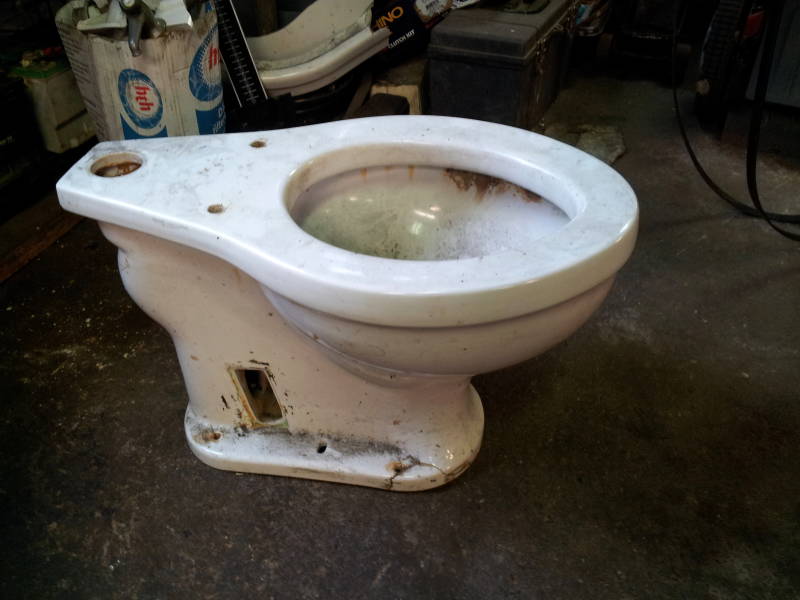
Toilets In Motion — Ship Toilets
Why is a Ship's Toilet Called a "Head"?
A toilet on a ship is called a "head", for reasons that
go back to the days of sail.
With nothing but wind power, a sailing vessel cannot
travel directly into the wind.
The one location that is always downwind is the head or
bow end.
<pirate>
Yarr, that be the "front" to ye land-dwellers.
</pirate>
To go to the head of a ship meant to go to the area
where the toilet is located.
The wind, as perceived on the vessel itself, would
always blow along the deck, appearing to come from behind
or possibly across the deck if sailing at an angle to
the wind.
This would carry most of the odor away.
The term poop deck has nothing at all to do with this! That term comes from poupe, the French word for the stern (rear) of a boat or ship. The French word poupe comes from the Old Provençal or Italian word poppe, which in turn comes from the Latin puppis. Not poop.
Originally there were just some rails around the base of the bowsprit that the sailor could lean against or sit on, hanging out over the water passing under the bow. By the early 19th century these rails had evolved to a plank seat with holes, a little more comfortable but still pretty crude.
Now, with various forms of engine power plus holding tanks and manual or powered pumps, the "head" can be anywhere. But the name stuck.
Marine toilets on smaller vessels must be designed differently, because the ship may be rocking from side to side, front to back, or both. Traditional toilets would spill water from the bowl. Marine toilets for smaller vessels are designed so the bowl is kept dry until it is used, then water is pumped into the bowl for cleaning and immediately pumped out. For an example, see the French canal boats below.
Let's look at some heads, the toilets on board Greek, Egyptian, American, and Scottish ferries, and on French canal boats. Plus, we'll see the toilet from Hitler's yacht.
French Canal Cruiser
Here is one of the heads and the flushing mechanism on board a rented Crusader canal boat in France.
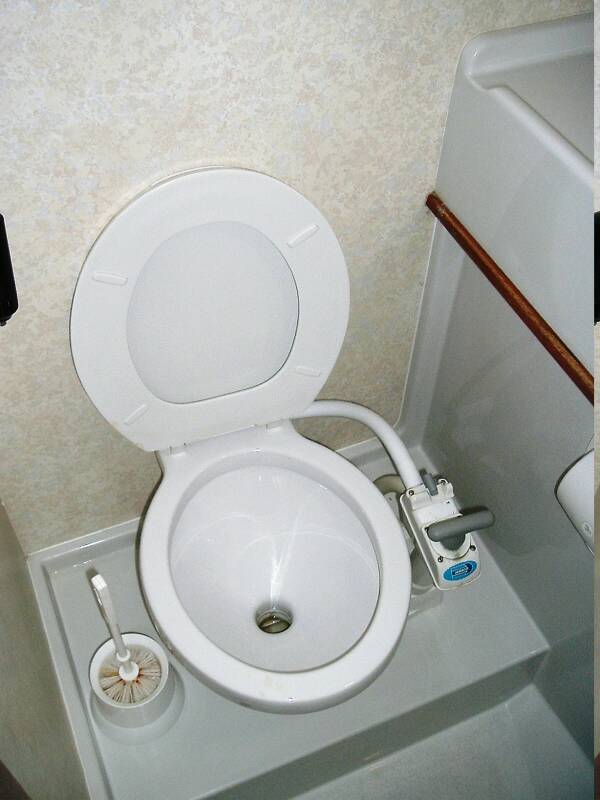
The entire small compartment is used as a shower. The deck level within the head compartment is slightly lower, so shower water doesn't go out into the passageway. So, you need to get the toilet paper roll, barely visible above, to dry safety before starting a shower! There's a small counter with a sink to your right as you face the toilet.
Below is a close-up of the T-handle used to manually pump out the Crusader head into the holding tank.
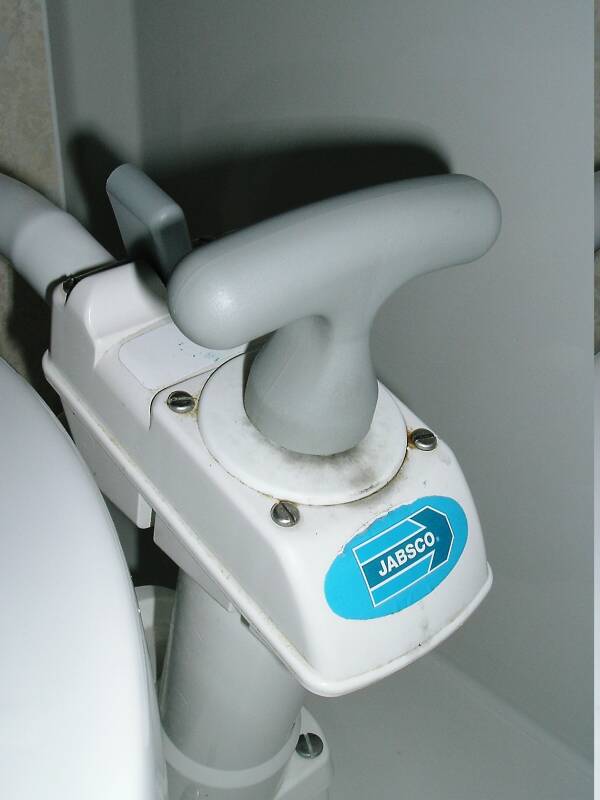
Below is the head on a very similar an Orion class rented canal boat in France.
The Crusader was derived from the earlier Orion design. The only differences I noticed between the two boat designs were:
A bow thruster was added to the Crusader design.
The main helm position is designed a little differently.
The domestic water supply is designed differently, with multiple much smaller pressure tanks on the earlier Orion versus a single much larger pressure tank on the Crusader.
The simpler toilets on the earlier Orion worked much better. The Orion toilets are operated by pressing a waterproofed button on the panel below the counter to pump water into the bowl, and stepping on a foot pedal (barely visible to the right of the toilet base) to open the large flapper valve into the holding tank. For much better performance, use the detachable shower spray nozzle. Again, the entire head compartment is the shower, see the second picture below with the drain in the floor. The Crusader heads had a complicated and poorly performing T-handle pumping mechanism.
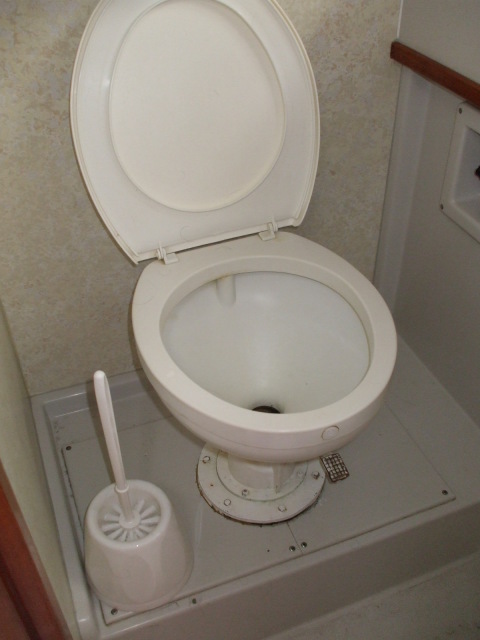
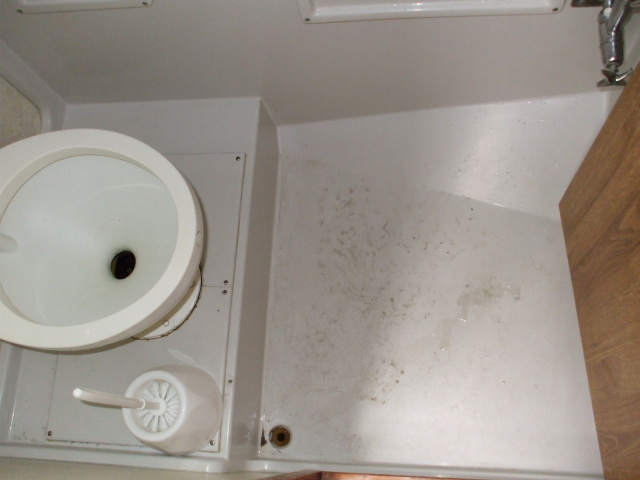 Canal du Midi
Canal Latéral
Canal du Midi
Canal Latéral à la Loire
I have taken these canal boats on trips on the Canal Latéral à la Loire between Briare and Decize, and on the Canal du Midi between Port Cassafieres and Castelnaudary.
Medieval Pilgrim Ship Toilets
Latin:
Volume 1 Volume 2 Volume 3
English, Palestine Pilgrims' Text Society:
Vol I, Part I Vol I, Part II Vol II, Part I Vol II, Part II
Felix Fabri or Felix Faber was a Swiss Dominican monk who lived 1441–1502. He is known for his descriptions of his pilgramages to Palestine in 1480–1484.
He studied at Dominican monasteries at Basel and Ulm. He spent most of his life at Ulm, outside his pilgrimage journeys.
On his pilgrimage in 1483–1484 he was accompanied by the Hungarian poet and cleric János Lászai.
The following translation of Felix's description of toilets on board the pilgrim ships is from A History of Private Life, Volume II, Revelations of the Medieval World
As the poet says, "A ripe turd is an unbearable burden." [ut dicitur metrice: maturum stercus est importabile pundus.] A few words on the manner of urinating and shitting on a boat.
Each pilgrim has near his bed a urinal — a vessel of terracotta, a small bottle — into which he urinates and vomits. But since the quarters are cramped for the number of people, and dark besides, and since there is much coming and going, it is seldom that these vessels are not overturned before dawn. Quite regularly in fact, driven by a pressing urge that obliges him to get up, some clumsy fellow will knock over five or six urinals in passing, giving rise to an intolerable stench.
In the morning, when the pilgrims get up and their stomachs ask for grace, they climb the bridge and head for the prow, where on either side of the spit privies have been provided. Sometimes as many as thirteen people or more will line up for a turn at the seat, and when someone takes too long it is not embarrassment but irritation that is expressed [nec est ibi verecundia sed potius iracundia]. I would compare the wait to that which people must endure when they confess during Lent, when they are forced to stand and become irritated at the interminable confessions and await their turn in a foul mood.
At night, it is a difficult business to approach the privies owing to the huge number of people lying or sleeping on the decks from one end of the galley to the other. Anyone who wants to go must climb over more than forty people, stepping on them as he goes; with every step he risks kicking a fellow passenger or falling on top of a sleeping body. If he bumps into someone along the way, insults fly. Those without fear or vertigo can climb up to the prow along the ship's gunwales, pushing themselves along from rope to rope, which I often did despite the risk and the danger. By climbing out the hatches to the oars, one can slide along in a sitting position from oar to oar, but this is not for the faint of heart, for straddling the oars is dangerous, and even the sailors do not like it.
But the difficulties become really serious in bad weather, when the privies are constantly inundated by waves and the oars are shipped and laid across the benches. To go to the seat in the middle of a storm is thus to risk being completely soaked, so that many passengers remove their clothing and go stark naked. But in this, modesty [verecundia] suffers greatly, which only stirs the shameful [verecunda] parts even more. Those who do not wish to be seen this way go squat in other places, which they soil, causing tempers to flare and fights to break out, decrediting even honorable people. Some even fill their vessels near their beds, which is disgusting and poisons the neighbors and can be tolerated only in invalids, who cannot be blamed; a few words are not enough to recount what I was forced to endure on account of a sick bedmate.
The pilgrim must be careful not to hold back on account of false modesty and not relieve the stomach; to do so is most harmful to the traveler. At sea it is easy to become constipated. Here is good advice for the pilgrim: go to the privies three or four times every day, even when there is no natural urge, in order to promote evacuation by discrete efforts; and do not lose hope if nothing comes on the third or fourth try. Go often, loosen your belt, untie all the knots of your clothes over chest and stomach, and evacuation will occur even if your intestines are filled with stones. This advice was given me by an old sailor once when I had been terribly constipated for several days. At sea, moreover, it is not safe to use pills or suppositories [pilulas aut suppositoria accipere], because to purge oneself too much can cause worse trouble then consipation.
Larger vessels which are more stable can use toilets which are a little more like the land-based ones we are familiar with. But not exactly the same! They are generally kept dry or at least with very little water in them routinely. If the vessels are only operated in relatively calm conditions, like the New York harbor ferries shown below, then the toilets can be more or less standard land units.
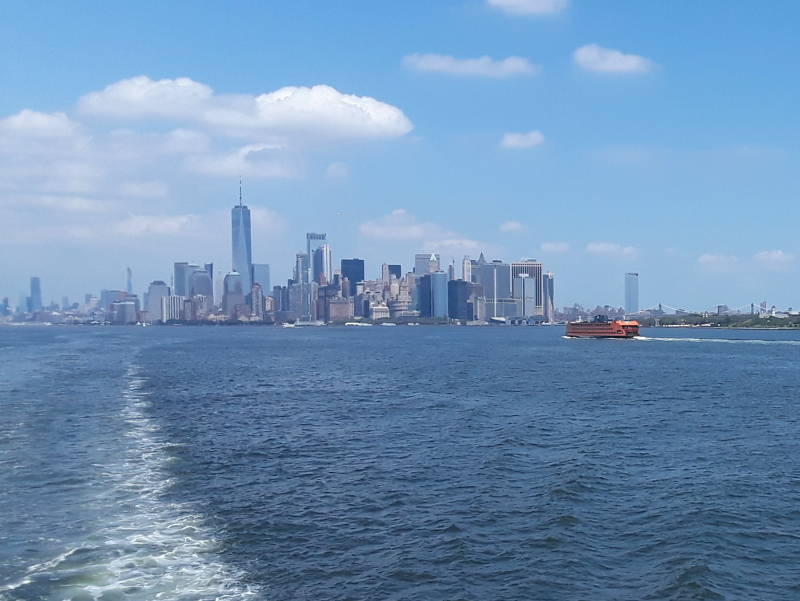
Staten Island Ferry, New York
The Staten Island Ferry, seen above, provides free rides from the lower tip of Manhattan (New York, USA), past the Statue of Liberty and Ellis Island, to Staten Island, and back.
If you need to go before you board, the first picture shows an all-stainless-steel model in the Manhattan terminal.
The second is one of the heads on board the ferry itself.
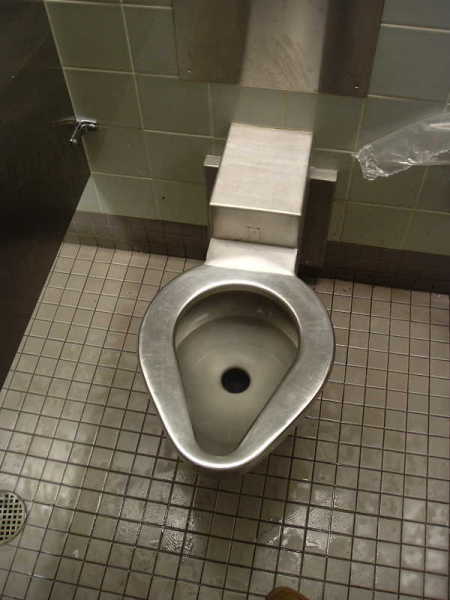
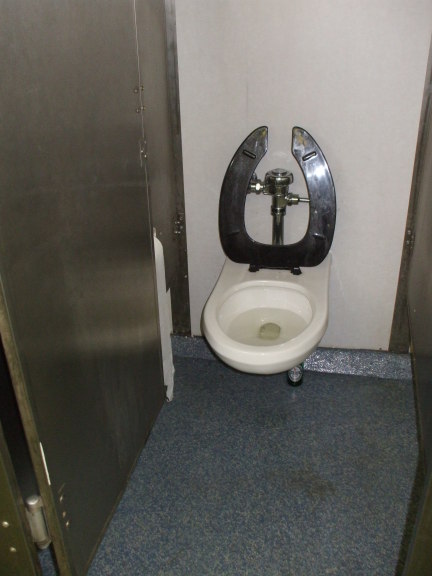
Some of the fixtures on board are ceramic, others are all stainless steel.
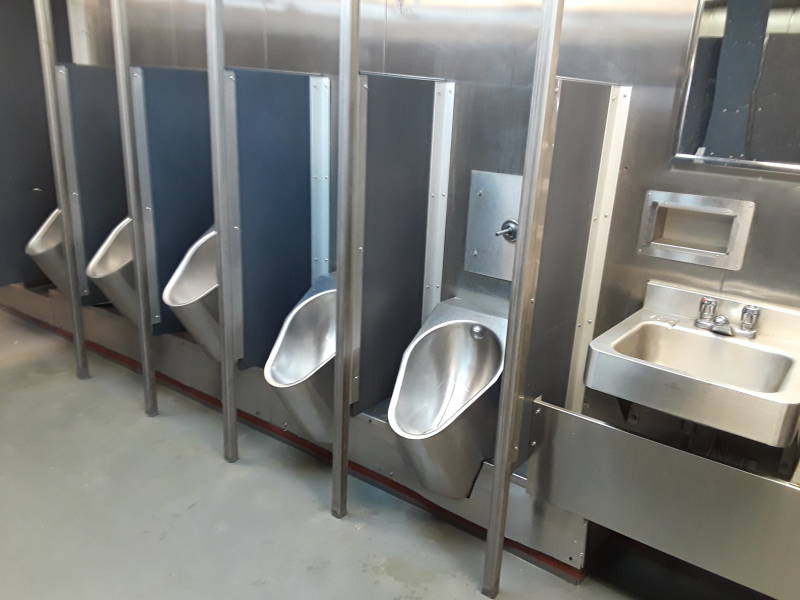
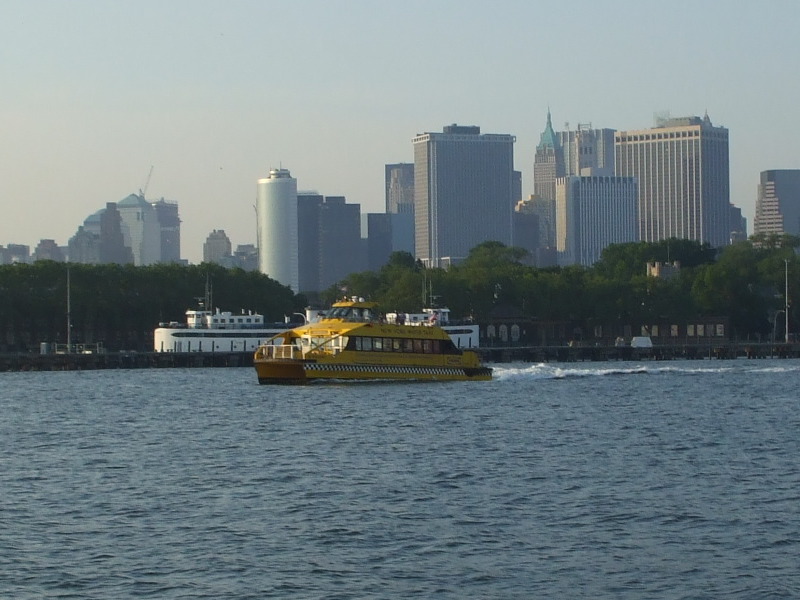
New York Water Taxi
The New York Water Taxi, seen above, is a smaller ferry crossing the East River between lower Manhattan and Brooklyn, Here is its on-board toilet. It looks like they flush with grey water. I have already flushed it.
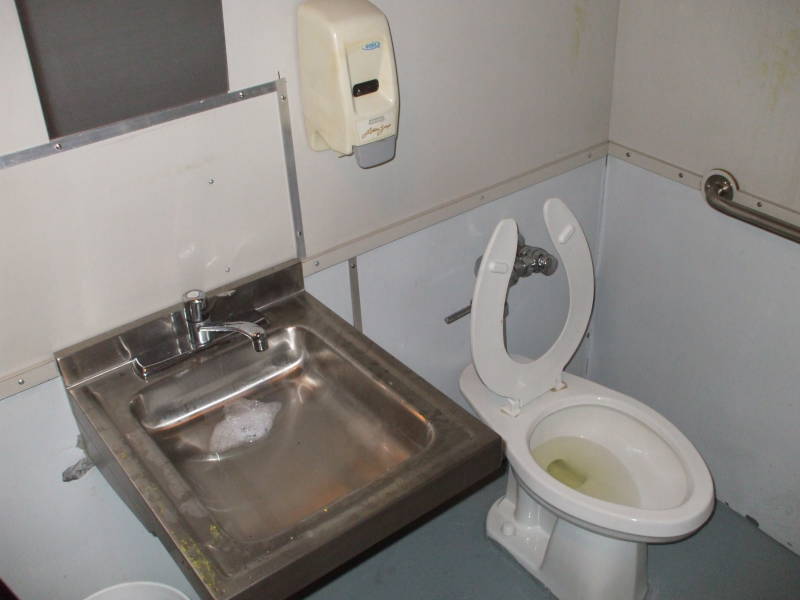
So far, this is about raised commodes. If you have a squat toilet, like the Egyptian ferry shown below, there is no bowl to hold water. What would be very important in that case would be either a one-way valve or one or more goosenecks adequately shaped, sized, and oriented to prevent stored liquid from re-entering the toilet from the storage tank.
Egyptian Ferry
This toilet is on an Egyptian ferry on Nuweiba-Aqaba route between the Sinai and Jordan. It has no sprayer, but at least there's a hose.
This is actually pretty nice by Egyptian public toilet standards. And I must emphasize that it's rust you see there!
This is from a trip from Cairo to İstanbul through Egypt, Jordan, Syria and Turkey.
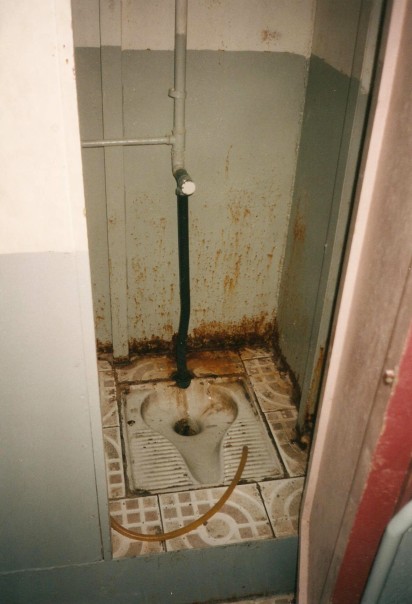
The toilet itself is just one component of what U.S. regulations call the MSD or Marine Sanitation Device. The important details are in the holding tank and whatever processing is done before the waste is pumped overboard, possibly discharged out into the water. If the waste isn't pumped overboard, it is stored in the holding tank until the boat returns to the dock and the holding tank is pumped ashore for treatment. The MSDs are classified as Type I, Type II, and Type III.
A Type I MSD must totally liquefy solids and paper, while reducing the bacteria count to less than 1,000 per 100 milliliters. It's a liquid, but it's very dirty. A Type II MSD must reduce the bacteria count to less than 200 per 100 milliliters, and also have less than 1,000 particles of suspended particulate matter per 100 milliliters. The resulting liquid is almost completely clear, although still colored. Types I and II would then discharge the resulting liquid out into the surrounding water, pumping it out through an opening called a seacock. A Type III MSD is a holding tank. Unlike the Types I and II, a Type III does not discharge any liquid into the water. It holds all waste until it can be pumped ashore for treatment.
Vessels up through 65 feet in length may use any of these three types. Vessels larger than 65 feet must use either a Type II or Type III. In other words, a larger vessel, with more people on board and thus more sewage, and with a larger overall budget, must get its waste much cleaner before pumping it overboard. Smaller vessels, with fewer people and less waste, are allowed to be much dirtier but at their smaller scale. A Type II MSD much larger, expensive, and power-hungry than a Type I, and so Type II MSDs are usually found only on larger vessels. A Type III MSD can be quite simple, and is likely the best choice as long it can be large enough for the planned time away from a pump-out facility.
So, if you're going to be away from the dock for a long time on a large vessel, you will need the expensive Type II. You will be at sea too long to keep it all in a holding tank, but it's a larger class of vessel with more people on board and so you must discharge cleaner material. Of course, if you can afford to buy a large yacht and go on extended trips, the addition cost of a Type II MSD is just a relatively small part. On today's yachts you would see high tech, lavish restrooms. If you were to look at Hatteras yachts for sale you would be amazed at the interiors of their bathrooms.
The need to make waste pumpable (Type I) and fully liquified (Type II) is why it's important that you put nothing down a marine toilet except human waste and special marine-use toilet paper. That toilet paper breaks down completely. A macerator is an electrically driven device that liquifies the waste, much like a kitchen blender.
You can probably see why there is a distinction between septic waste and grey water. Septic waste from the toilets only, handled by the MSD, versus grey water from showers and sinks. You don't want to macerate or store any more than you have to. However, in some areas such as the Great Lakes between the U.S. and Canada, you have to hold grey water on board.
Greek Ferries
Travel byGreek Ferry
The larger Greek ferries have multiple passenger decks above vehicle decks sized to carry trucks. This scenic head is on board the M/V Artemis ferry en route from Ios to Santorini in the Aegean. It's not in the bow, it's looking out to the side from one of the upper decks.
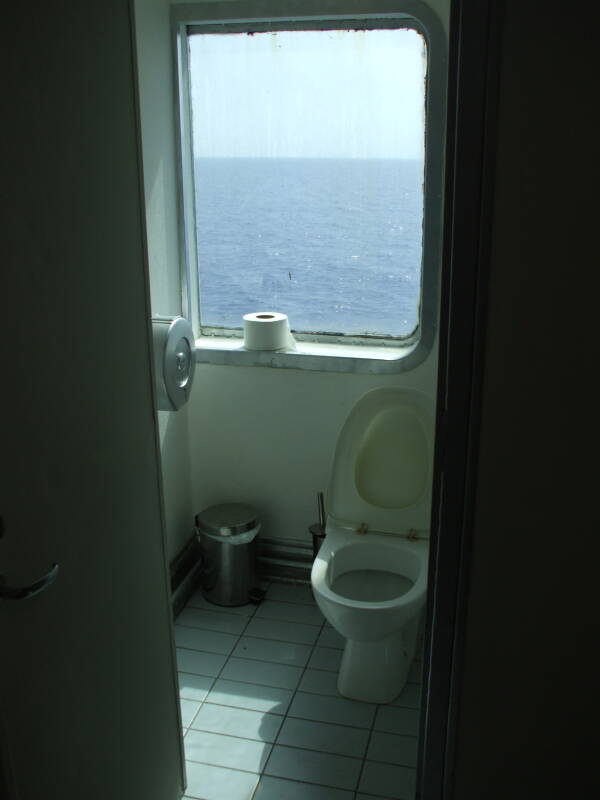
The Artemis is the smallest conventional ferry of the Hellenic Seaways line. 89.9 meters long, 14 meter beam, carrying up to 1,250 passengers and 74 cars at a speed of 18 knots.
That sounds large to me, but the same company operates the Nissos Mykonos and Nissos Chios at nine times the gross tonnage each, 141 meters long, 21 meter beam, and 1,915 passengers and 418 cars, running at 28 knots.
The conventional ferries are great ways to travel between Greek islands. They have large open decks and great views. The high-speed ferries get you there faster but you can't see as much along the way.
Here is a head on board the M/V Blue Star Delos en route from Thira to Naxos. The Delos can carry 2,400 passengers and 430 vehicles at 25.5 knots. Its heads each have a bin for the paper, and a brush for the #2.
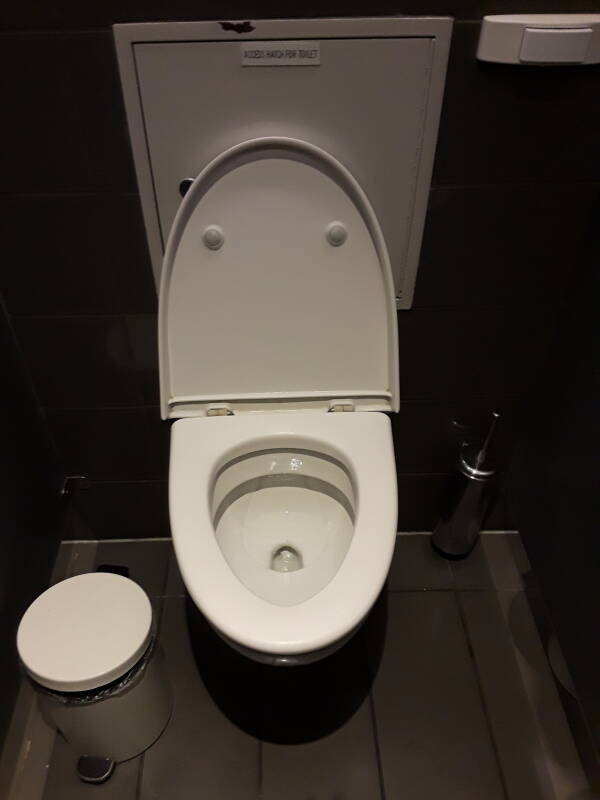
This head is on board the M/V Blue Star Mykonos en route from Mykonos to Piraeus, the port of Athens. The same speed and nearly the same overall dimensions as the Delos, but with a slightly smaller capacity: 1,915 passengers and 418 vehicles.
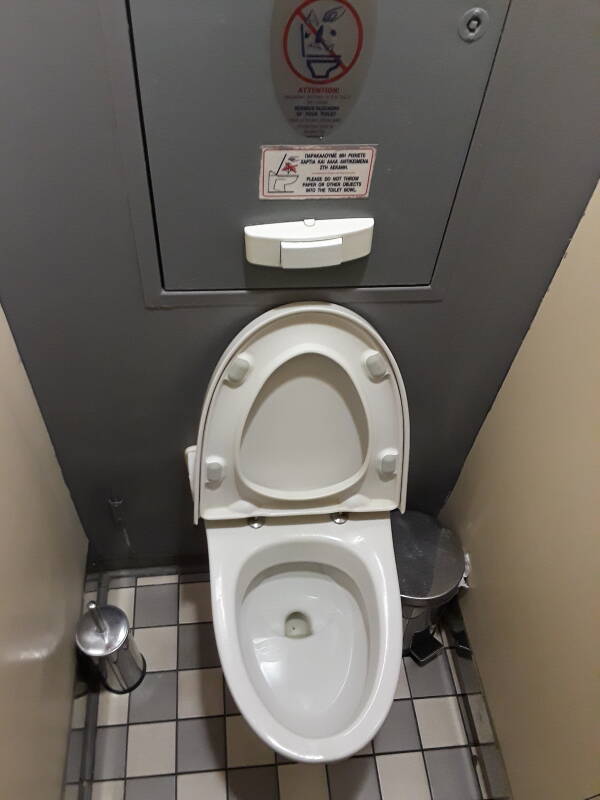
The M/V Dodekanese Express is a smaller ferry running the Samos — Patmos — Agathonisi — Leipsoi — Leros — Kalimnos — Kos route. I had boarded on Leros, and here we have just left Kalimnos port for Kos.
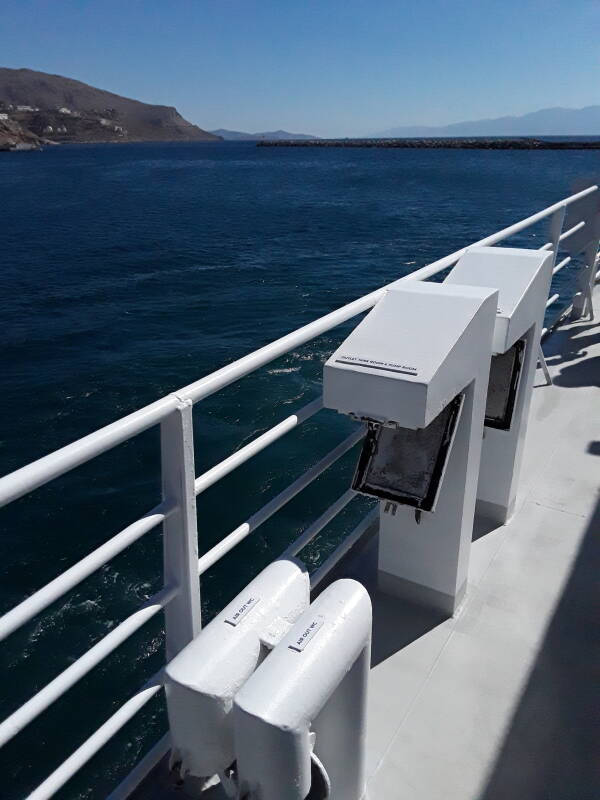
The two taller vents are labeled "OUTLET TANK ROOM AND PUMP ROOM", The short ones are labeled "AIR OUT WC"
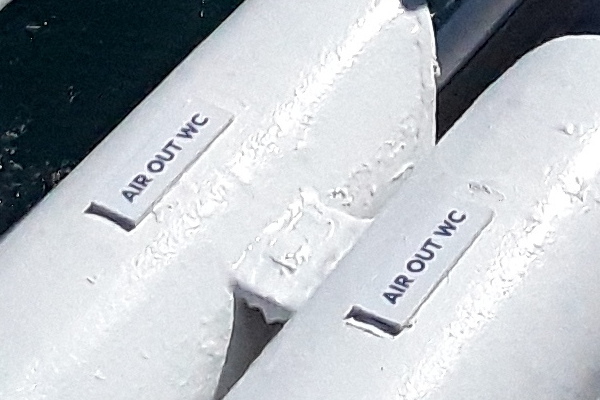
Here's what one of those is venting, the men's head on board the Dodekanese Express.
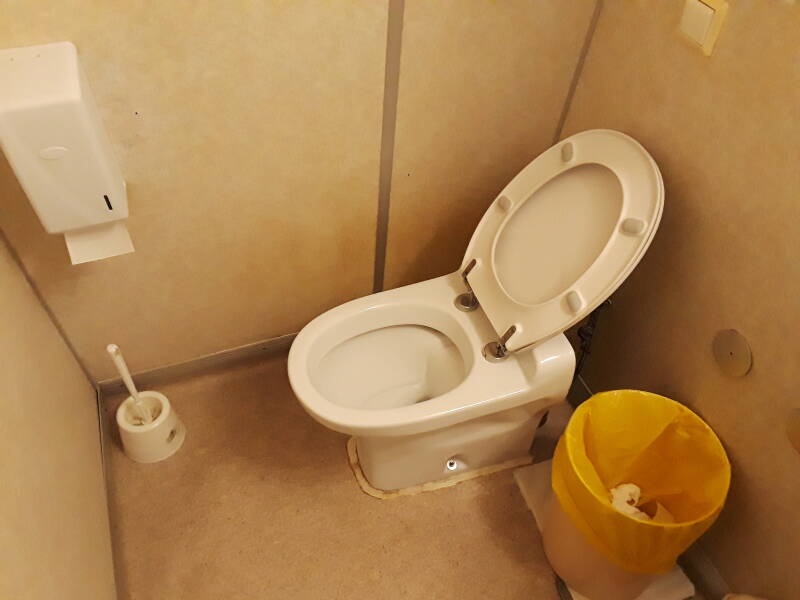
Even the conventional ferries make fast port stops. They drop the rear ramp, drive any cars and trucks off and on, and load passengers off and on. Some have a single wide ramp and passengers wait for the vehicles or vice-versa, others have a second narrow ramp just for passengers. And, of course, at small islands there may be no vehicles getting on or off. In those cases the ramp may only be on the pier for seven minutes or less.
Be on time, don't miss your boat!
Orkney Island Ferry
The M/V Hamnavoe, seen here, links the Orkney Islands with the north coast of Scotland.
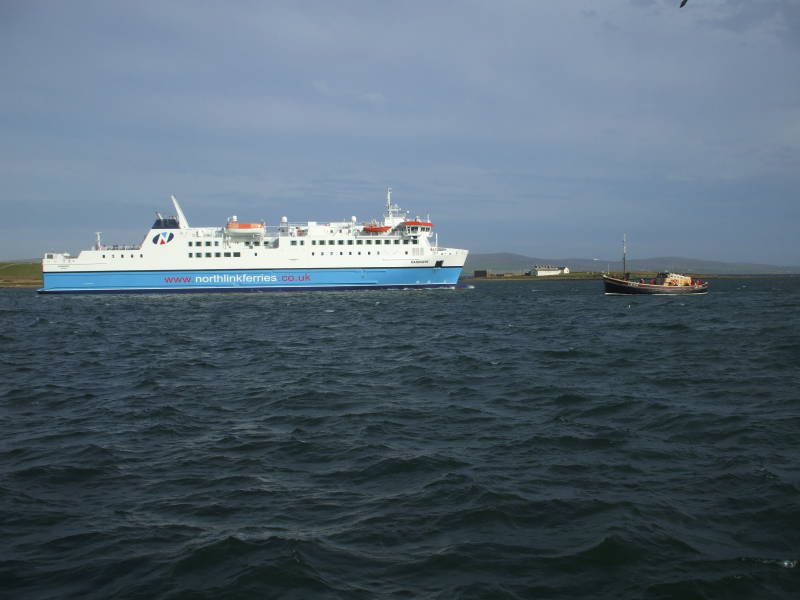
There are several sailings a day, 90 minutes en route each direction.
Here are the heads.
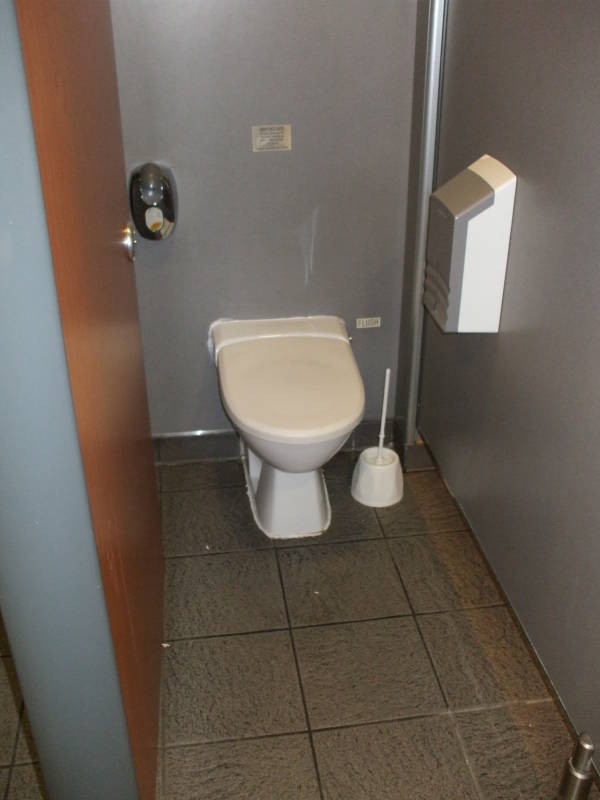
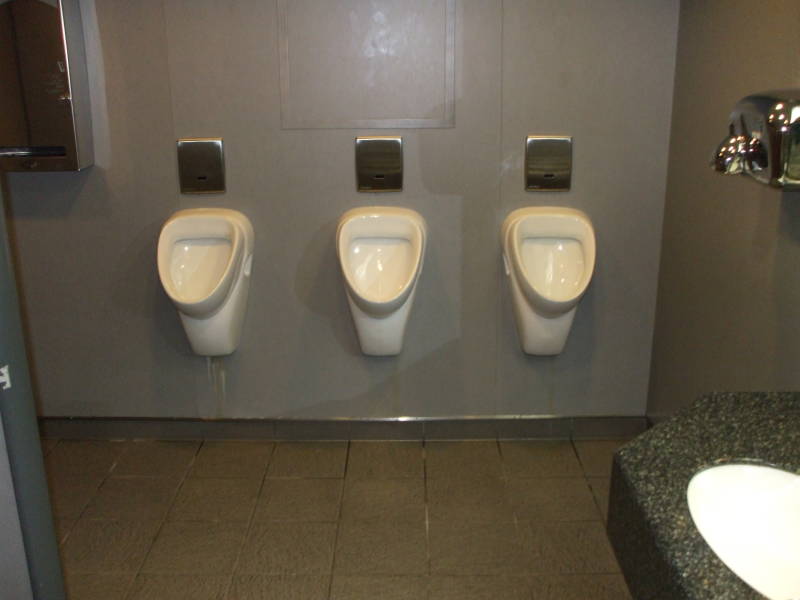
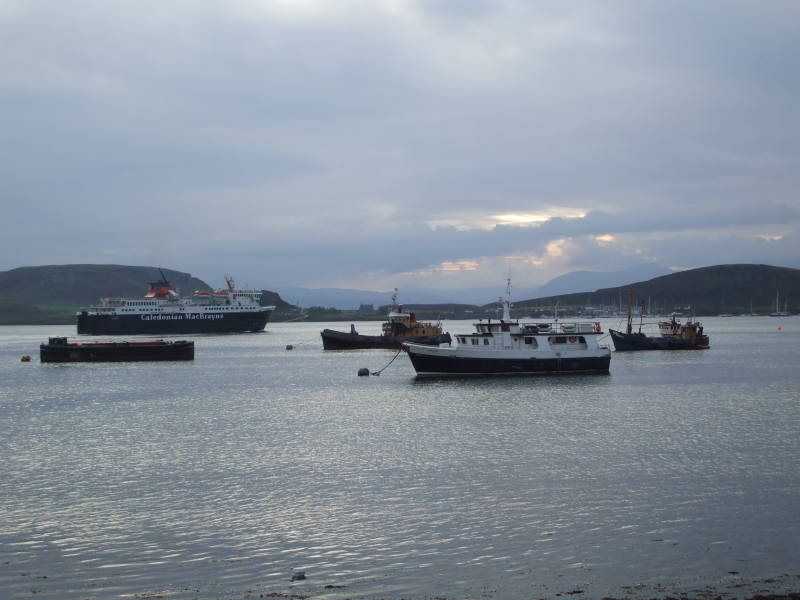
Inner Hebrides Island Ferry
The M/V Isle of Mull of the Caledonian MacBrayne line, shown above, is one of the many ferries connecting the Inner Hebrides islands with the west coast of Scotland.
Here is one of its heads as photographed during a trip from Oban to Craignure on the Isle of Mull.
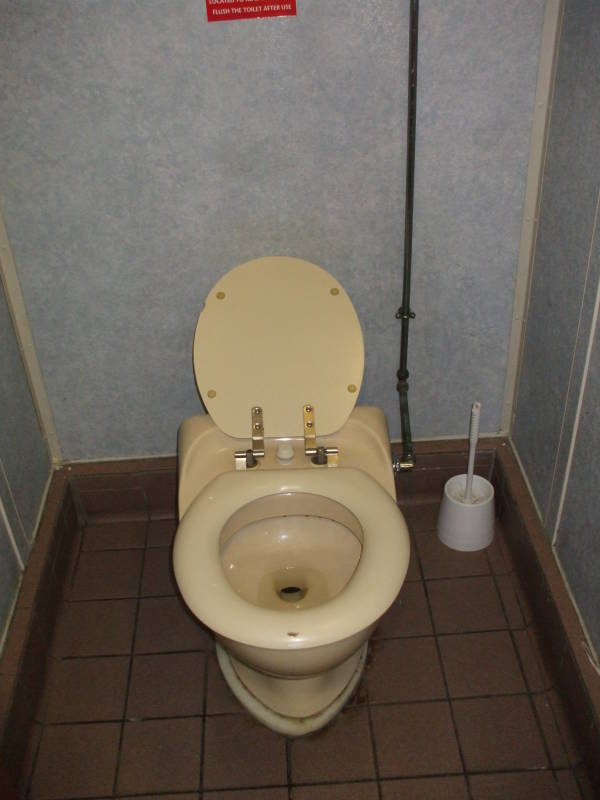
Adolf Hitler's Toilet
Adolf Hitler'sMaritime Toilet
German madman Adolf Hitler led Germany from 1933 until his suicide in 1945. He wanted to rule the world, but the only throne he ever occupied is a ceramic commode that came to sit in an auto repair shop in a small town in New Jersey.
The Grille was the official State Yacht of the Third Reich. It was converted to military use during World War II, laying mines along the coast of France and patrolling in the Baltic Sea. Karl Dönitz stood on its deck on 1 May 1945 to announce that Hitler had committed suicide as the Soviet Red Army was taking Berlin, and Dönitz was now Germany's leader.
The British Royal Navy seized the Grille at the end of the war, and sold it to private owners in the U.S. in 1947. In 1951 its owner scrapped the ship after removing and selling a lot of small pieces — portholes, flag poles, decking, and some plumbing.
The owner of an auto repair shop needed a toilet and sink for his garage, and happened to be good friends with the surplus ship's owner. He installed them in his garage, and there they sat and functioned for sixty years, through the purchase of the garage by a new owner.
See the dedicated page for many more pictures and historical details.

